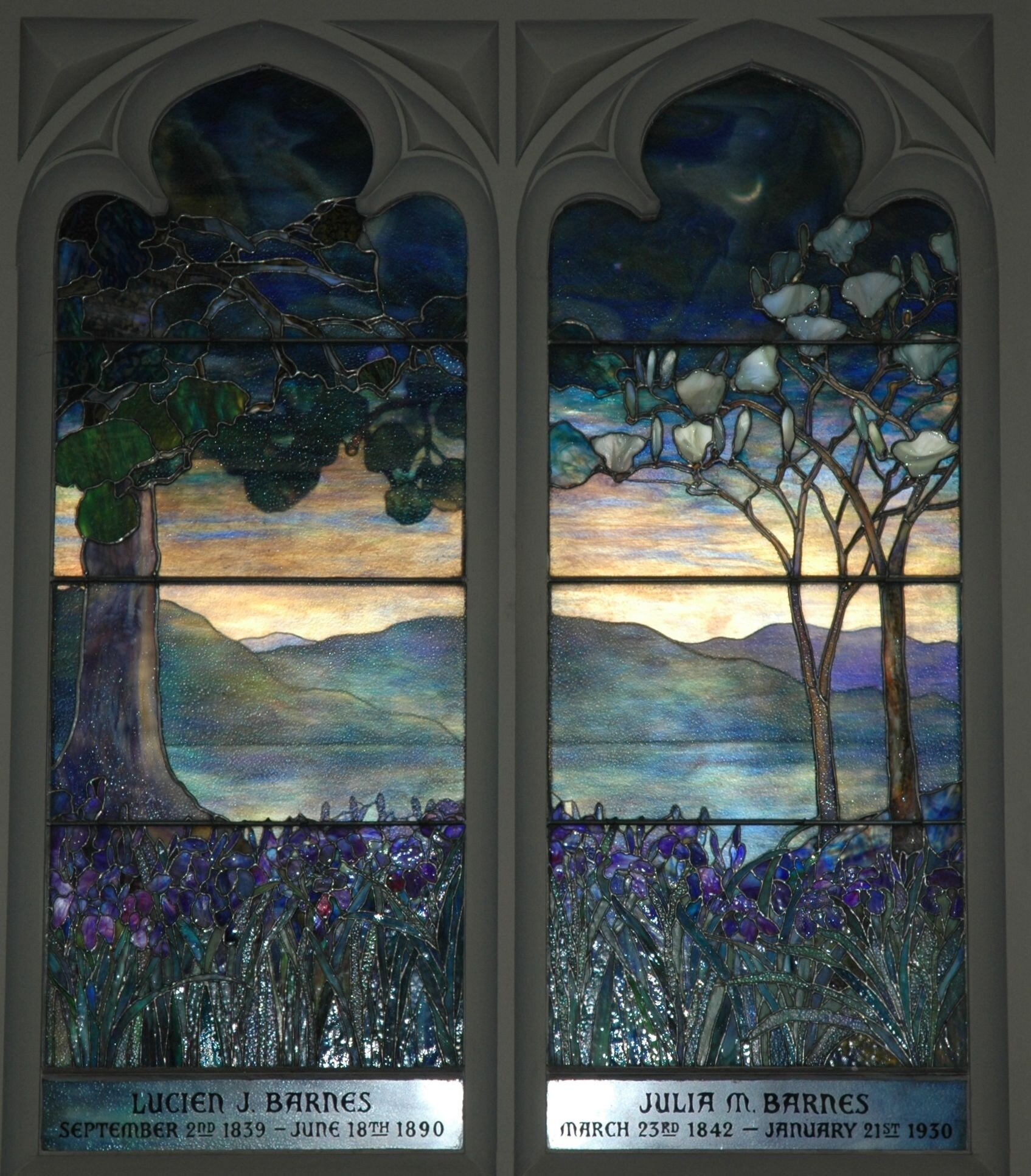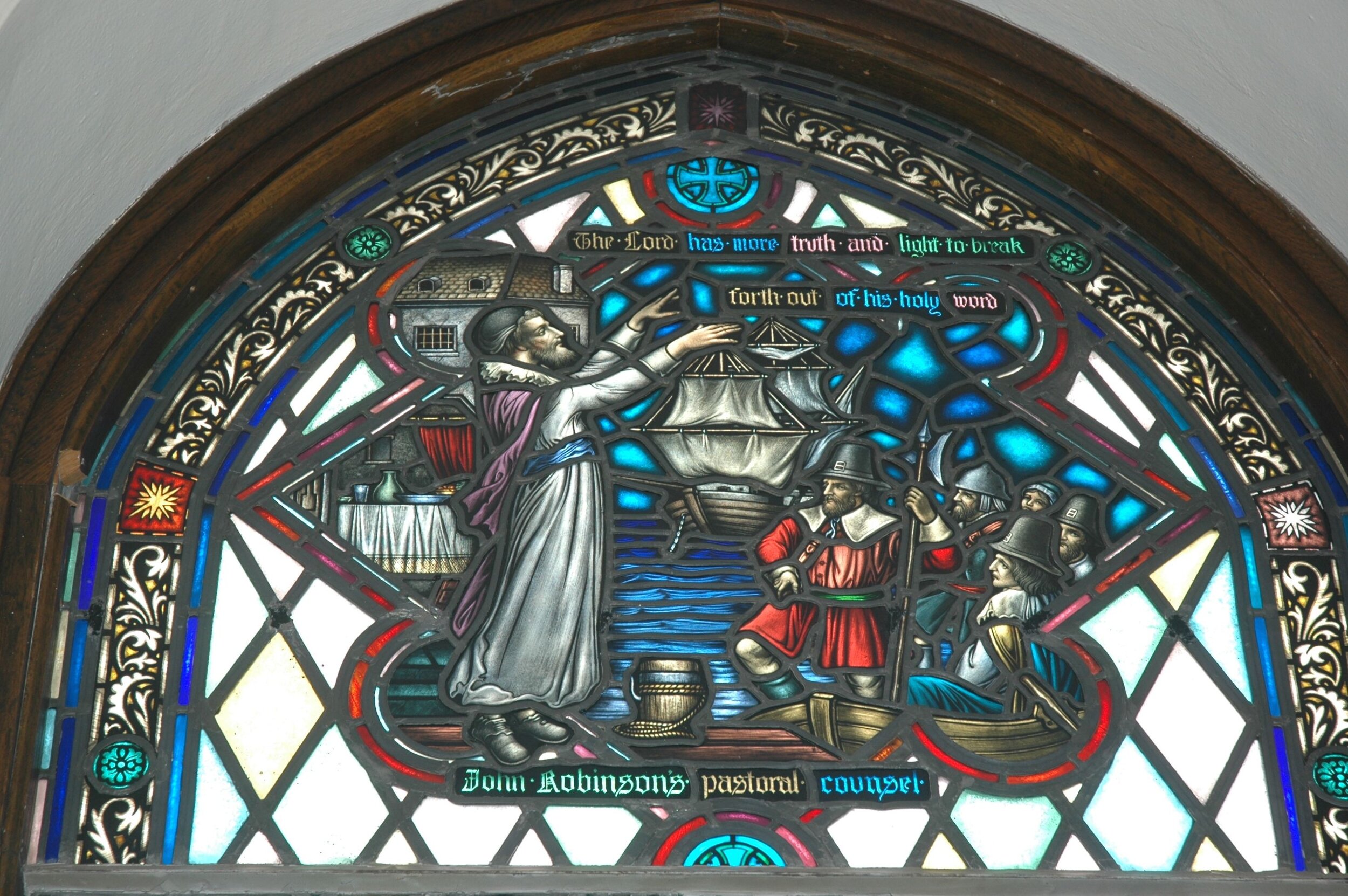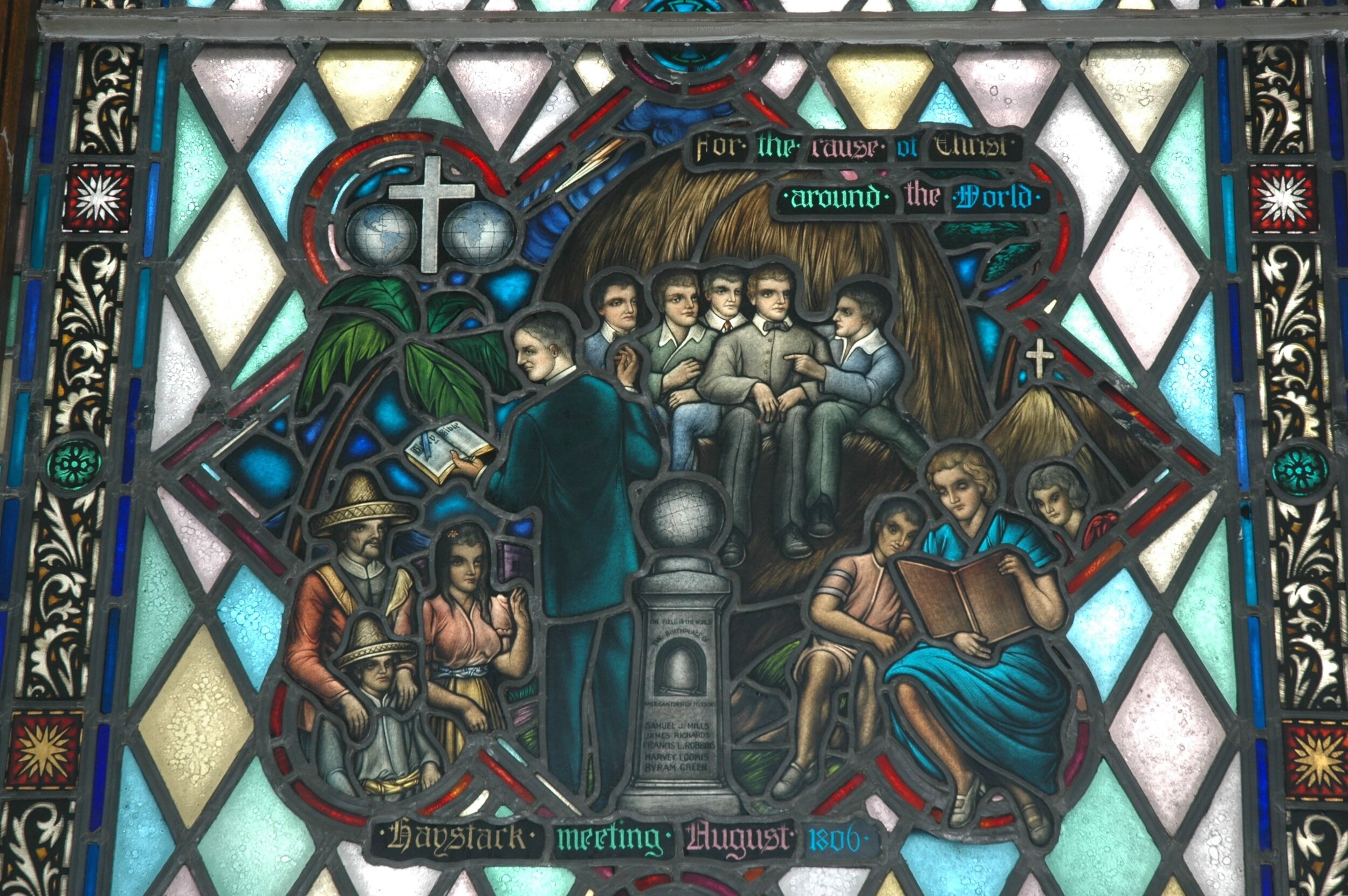
The Windows of Pilgrim Church
The following is adapted from descriptions originally written by R.F. Shepard in 1979.
The Tiffany Windows
There are five paired windows made by the Louis C. Tiffany Studios in New York. All depict outdoor scenes with mountains, lakes, trees and flowers. Three bear the Louis C. Tiffany signature; one (the Field Window) is ascribed to “Tiffany Studios.” The Barnes Window does not bear the Tiffany name, but is believed to be authentic. In contrast to the transparent glass used in most older stained glass windows, Tiffany used translucent glass streaked and mottled in color and plated, or layered, to achieve the desired effect. The Tiffany firm went out of business in 1926.
The Hoopes Memorial Window
Nearest to the narthex on the south side of the building is the Hoopes Memorial Window. It was dedicated in honor of the church’s fiftieth anniversary in 1921.
The Field Memorial Window
The Field Memorial Window, shows 1918 as the date of manufacture.
The Barnes Memorial Window
The Barnes Memorial Window does not bear the Tiffany name, but is believed to be authentic.
The Duncan & Hegardt Window
The Charles A. Duncan and William G. Hegardt Memorial Window.
The Matter Memorial Window
The Matter Memorial Window was installed in 1923, three years before the Tiffany Company went out of business.
Tiffany-style Windows
The Hornby and McGonagle Memorial Windows
The Hornby and McGonagle Memorial Windows were made and designed in 1954 by Westminster Studios of New York, a successor firm to the Tiffany Company. Though cost prohibited a complete duplication of the Tiffany production process, these windows are made of Tiffany glass and styled to appear like the older windows. Proprietor of Westminster Studios at that time was the artist Oscar Julius.
The McGonagle Memorial Window (Second Panel)
The second panel of the McGonagle Memorial Window is dedicated to “a host of men and women whose love and devotion to Christ and the Church are an abiding Inspiration.”
The Vestibule “History” Windows
In the vestibule of the church are two windows installed in 1957 by Edward M. Leighton of Minneapolis. These were planned after extensive research by Dr. William L. Halfaker, who was then senior minister. Each window shows three important scenes in the history of American Congregationalism.
The Weaver Memorial Window
At the top we see John Robinson, pastor of the exiled English congregation in Leiden, The Netherlands. He is delivering his farewell sermon to the company departing from Delfthaven on the pilgrimage that led them to the founding of Plymouth Colony.
The center panel of the Weaver Window depicts the signing of the Mayflower Compact.
At the bottom panel of the Weaver Window, Thomas Hooker addresses the first colonial legislature (The General Court) of Connecticut.
The Walker Memorial Window
The top scene of the Walker Memorial Window shows the founding of Harvard College to continue the tradition of a learned ministry.
In the center of the Walker Memorial Window, we see the Haystack Prayer Meeting on the campus of Williams College. This meeting of students in a thunderstorm led to the founding of the first American foreign mission society.
The bottom panel of the Walker Memorial Window shows Lyman Abbott delivering a sermon attacking slavery in Terre Haute, Indiana, just before the outbreak of the Civil War. A printed copy of the sermon resurfaced while Dr. Halfaker was minister of the same Terre Haute church.
The Roberts Memorial Window
The following description of the Roberts Memorial Window was written by its designer, Odell Prather, on the occasion of the window’s dedication on October 14, 1979:
“Much of the church’s history has been used as thematic material in the narthex windows. The theme of the chancel window design is also based on historicity, but from a different angle. The subject of this window Is EDUCATION, as an extremely important part of the organized Christian work of the founding American Congregationalists. There is a most impressive record of the impact Congregationalists have had upon American Institutions of higher learning. The church has founded so many famous colleges and universities; it seems to me that this important function should be celebrated.
“I found a venerable book (published in 1894), “Congregationalists in America*, by the Rev. Albert E. Dunning. D.D., containing pen and ink sketches of some of the university and college buildings. I selected a few of these buildings which could be simplified greatly into diagrammatic drawings; their selection hinged on the way they would combine aesthetically as much as on any other factor. (In a later paragraph I shall list the buildings which were thus abstracted). The building diagrams are vignetted, arising from and fading into the background glass, to keep them from being too detailed or too dominant.
“Flame-like forms symbolize the flames of the Holy Spirit. On either side are the symbols of education: the oil lamp and the open book.
“Near the bottom of the window flows the stream of Living Water, and at the far left and the far right are two tall trees which stand for the Tree of Life and the Tree of Knowledge. At the top center of the principal panels is the symbol which represents the emblem of the United Church of Christ.
“In the tracery there are a few more symbols. The star of Incarnation is In the center quatrefoil at the top. The buildings Indicated In the right and left portions of the tracery Immediately above the main panels are symbolic of the Holy City, the New Jerusalem. (Aesthetically, they form a balance for the buildings in the main panel.)
“The colors have been chosen to harmonize with those In the existing windows. The rich reds, blues, golds and olive greens parallel the colors In the side windows. The light tints (which we think of as “whites” In glass) help to balance the light clerestories as well as some white cloud representations In the landscapes. The theme also harmonizes with the landscape windows of the nave, by using trees – not only the two symbolic ones, but also some of the native white birches.
“The historic colleges and universities represented here by the diagrammatic drawings follow In a counterclockwise order:
Bottom: Osborn Hall, Yale University. New Haven, Connecticut
Above Yale, at the right: Memorial Hall, Harvard University. Cambridge, Massachusetts
Top right: Jubilee Hall, Fisk University. Nashville, Tennessee
Upper left: Mount Holyoke College. South Hadley, Massachusetts
Center, in back of Harvard: Peters Hall, Oberlin College. Oberlin, Ohio
Left, below Mount Holyoke: Wheeler Hall, Northland College. Ashland, Wisconsin
“These buildings are not realistically rendered; if they had been, they would have lost their character as symbols. A few main features have been used, abstracted as they are in order to represent the part which the church has played in fostering education. It has furnished one of the principal foundation stones of American life.”
The Windows from the Lake Avenue Church
Two windows were moved to this building from the church structure that stood on East Second Street at the corner of Lake Avenue, and which Pilgrim Congregational Church occupied from 1888 to the fall of 1915.
The second window moved from Pilgrim Church’s original Second Street location is the Woodgridge Memorial Window. The window (some might call it four windows in a series) was given in memory of the Reverend Jonathan Edwards Woodbridge. A separate panel is devoted to a traditional depiction of each of the Four Evangelists. This window is inscribed with the name of the maker, “J.B. Anglade. Paris” and is dated, 1888. Note that the figure of Matthew has six toes on both feet!?!
The Munger Memorial Window, which depicts Christ with a globe in his hand, is located in the ceiling of the chapel located on the second floor.
Learn More
View the video below to learn more about the history of Stained Glass in the Northland
A video written and produced by Jack Salmela, 2011. Presents a thorough discussion about the stained glass windows of Pilgrim Congregational Church, 2310 East...
















